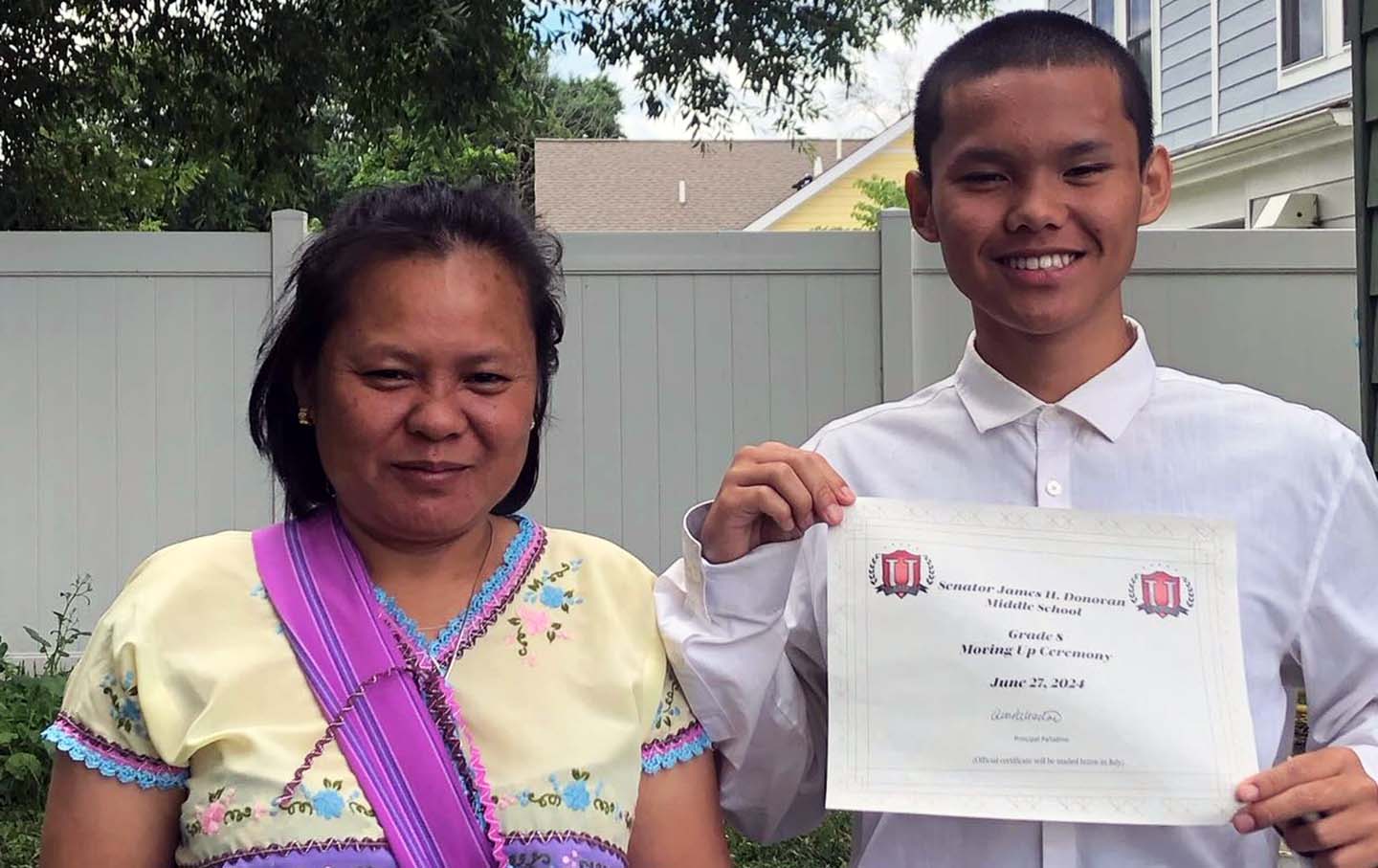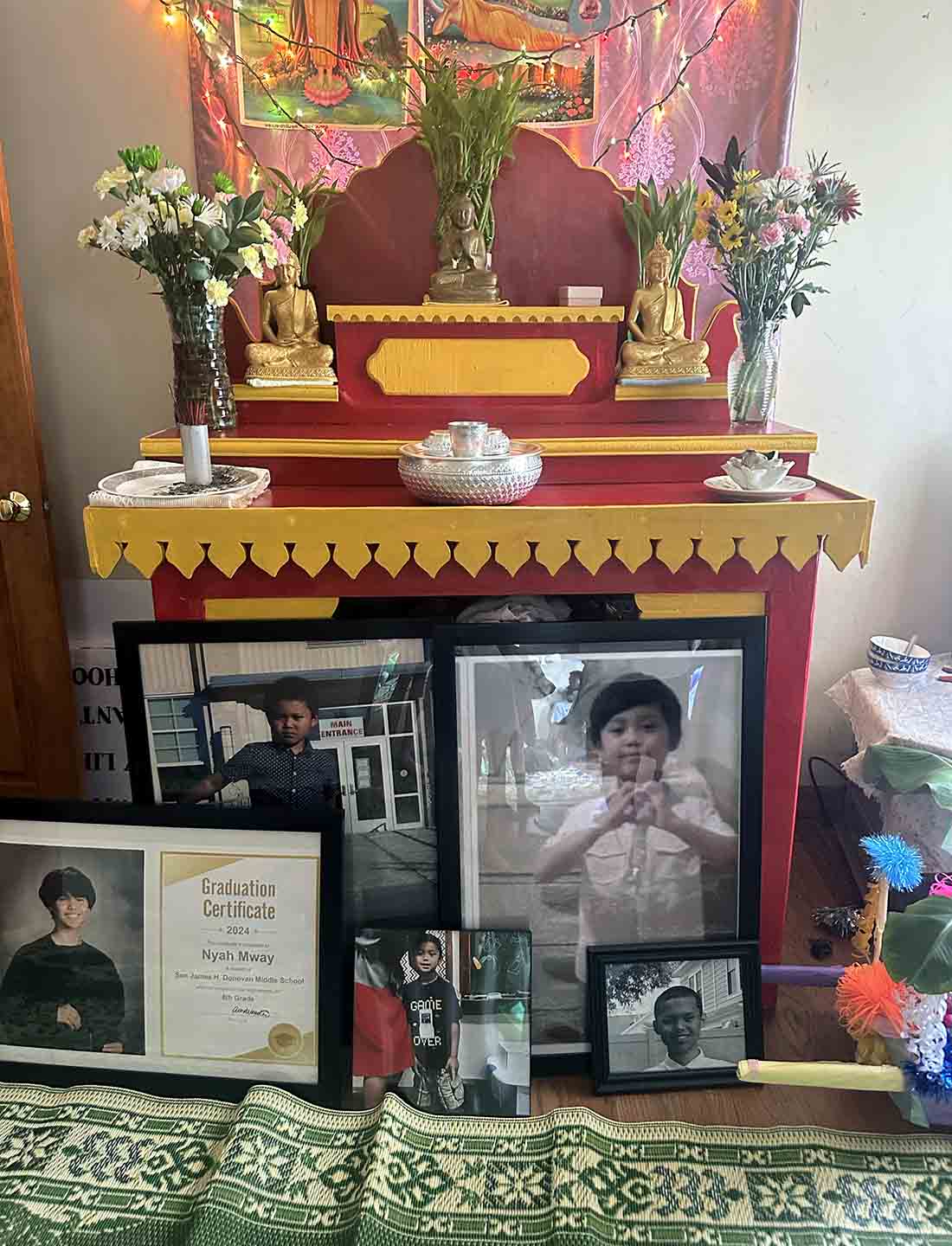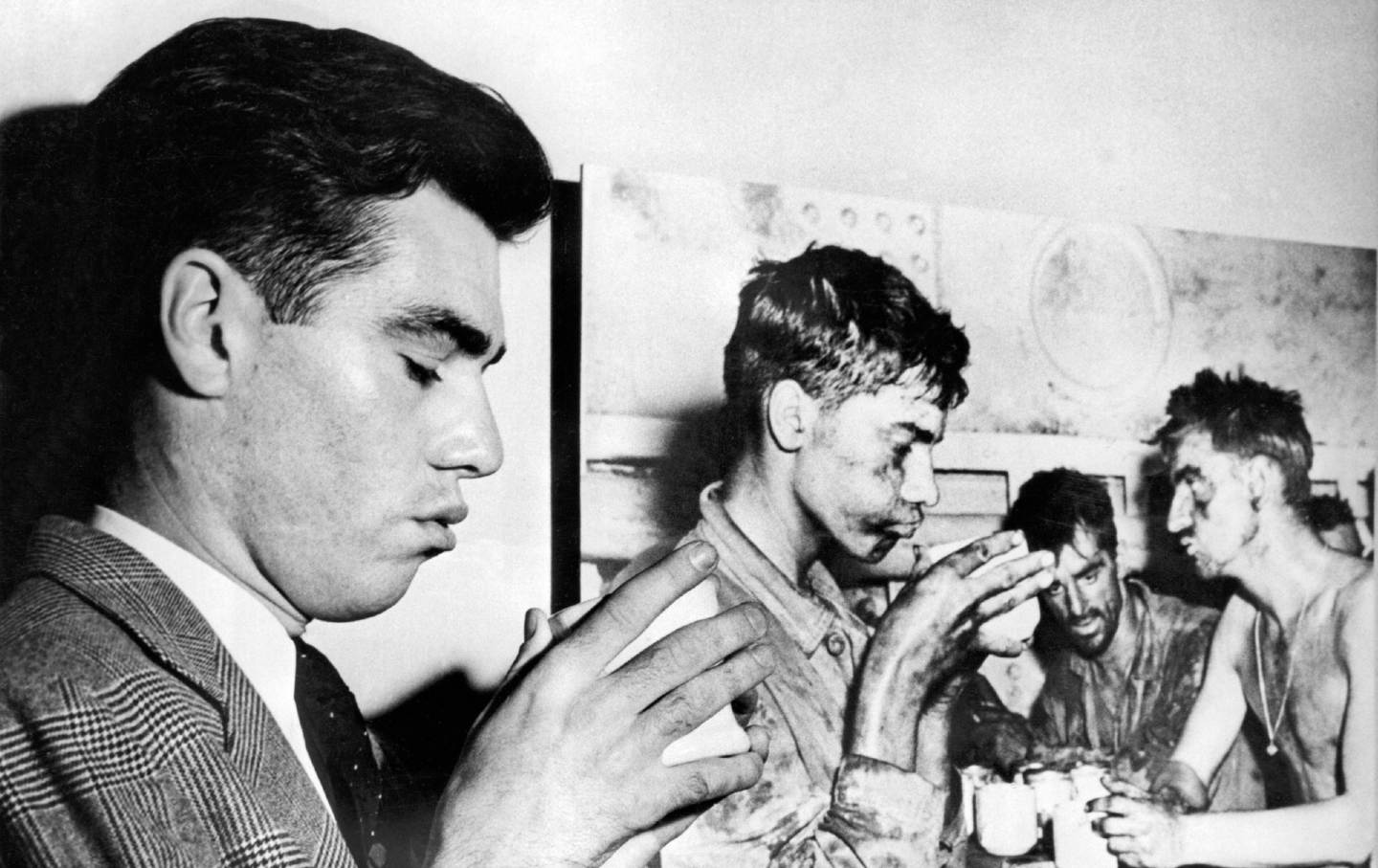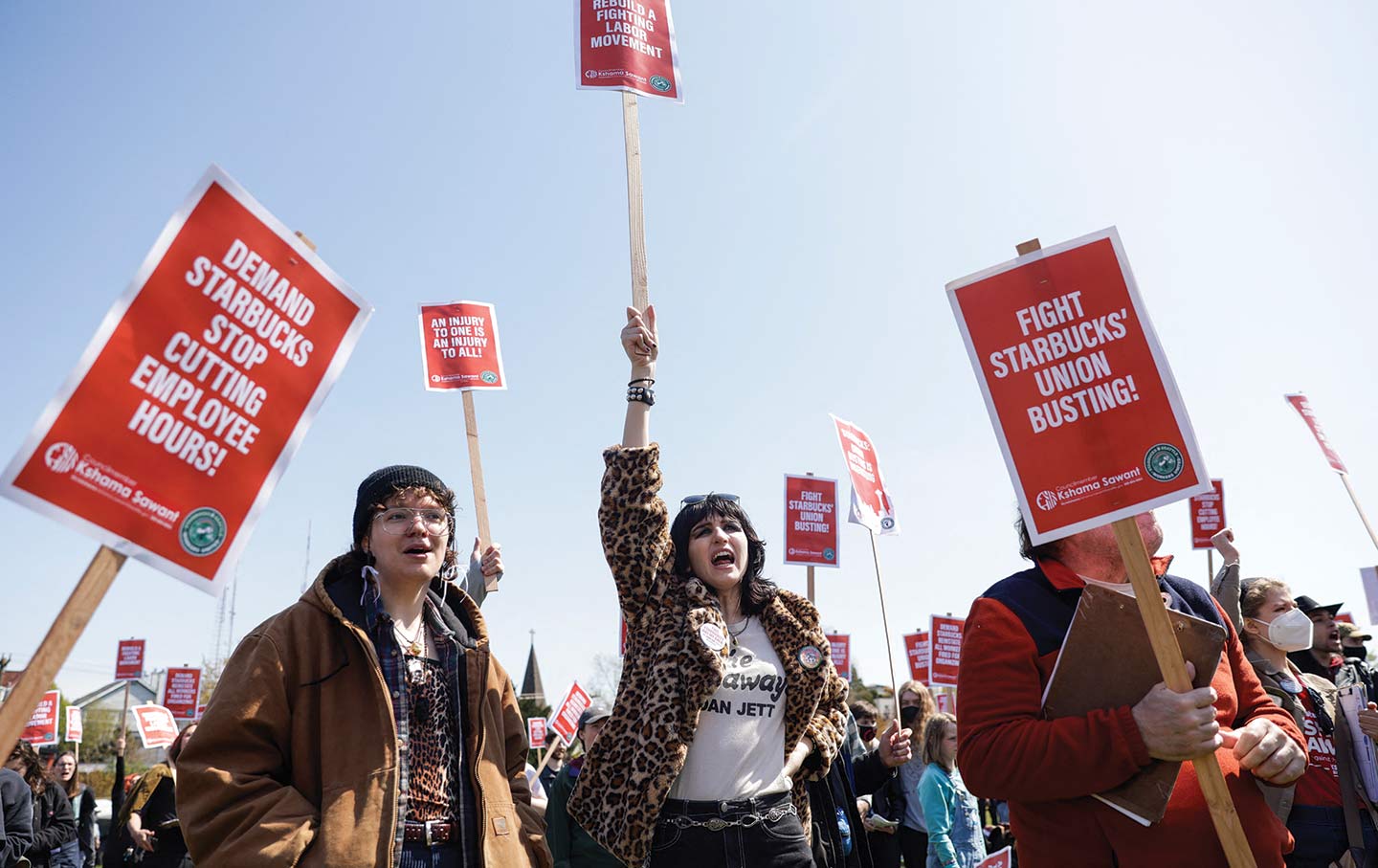The Police Killed Nyah Mway. Utica’s Refugee Community Demands Justice.
Nyah Mway graduated middle school. The next day an officer shot him dead.

Nyah Mway and his mother, Chee War, celebrate Mway’s graduation from middle school on June 27, 2024, the day before Utica police killed him.
(Thuong Oo)
Utica, New York—In Cornhill, a Black and Asian majority neighborhood in Utica, the sidewalks are uneven with chunks of broken concrete littering the ground like cast-off puzzle pieces. Flatweed and clover peek out of the cracks, and overgrown brush sags into the walking space.
The sidewalks are inconvenient to navigate, and so on the night of Friday, June 28, Nyah Mway, a Karen refugee from Myanmar, and a friend with his bicycle walked in the street. The two 13-year-olds had graduated from Donovan Middle School the day before. They’d just left a Bible study club and a graduation barbecue party. They were headed to their homes—the last summer before high school stretched out before them.
At 10:18 pm, three police officers stopped them for jaywalking. It’s a stop-and-frisk. There have been two robberies in Utica, and these kids fit the description.
Mway raised his hands but a second later put them back into the pockets of his hoodie. Officer Bryce Patterson instructed Mway to keep his hands up and announced they would pat him down for weapons. Mway took off running, and the officers gave chase.
The footage from Patterson’s body cam shows a shaky, mad dash. Mway’s back and the street blur into streaks of red and blue from the Utica Police Department patrol cars. Then, an edited freeze-frame image interrupts the video, with a thick red circle around an object in Mway’s hands as he appears to turn, mid-stride, toward the officers. The officers believe it to be a firearm; it’s later discovered to be a BB gun.
Seven seconds after the pursuit began, Mway stumbles to the ground. As he gets up, Patterson slams him back onto the ground and repeatedly punches him in the face. Officer Patrick Husnay, who joins Patterson above Mway, points his gun at Mway and shoots him in the chest, killing him. It’s 10:19 pm.
Nyah Mway was born in the evening of August 8, 2010, in the Umpiem refugee camp in Thailand near the Myanmar border. His grandfather gave him a Burmese name: Nyah Mway, after a rare flower that only blooms at night. He was the third of four siblings. Seven years later, Mway named his baby sister Paw K War, meaning “blooming flower,” so that their names would match.
Mway’s family fled the Myanmar military junta’s campaign of ethnic cleansing and persecution. Before resettling in Utica, they spent 10 years in the refugee camp. One day, Mway’s father Ka Lee Wan left camp to find work opportunities. He stepped on a landmine. He survived, but he lost a leg.
Mway’s oldest brother, Thoung Oo, also has a leg injury. When he was 3, he fell from their home in the refugee camp and dislocated his leg. It got infected and never fully recovered.
Mway, Oo said, “wanted to become a doctor to try to fix my leg.” The two brothers shared their dreams with one another. Mway would become a doctor and find the cure for Oo’s leg where previous doctors had failed; Oo would become a successful rapper and buy a home for his family.
Now Oo is 19 years old. He never finished high school but said he wants to go back to school for Mway. When I met with the family in their rented Cornhill home, Oo’s leg was infected again. It was wrapped in a large bandage, yellow pus seeping through. From the top of the bandage, I could see part of a deep gash, a long wedge of skin missing from Oo’s previous surgeries.
Mway slept in a storage closet off the living room. At 13, he was already taller than his father and his two older brothers, and he loved that little space of his own. His favorite food was a beef patty from the corner store, which he always bugged Oo to pick up for him after a work shift. (Oo and Wan are the breadwinners of the family: Oo works in a sushi restaurant in the wealthier neighboring suburb of New Hartford, while his father makes metal frames in a factory). Mway loved sports—volleyball, football, basketball, wrestling, soccer—but above all, he loved spending time with his friends. He’d play anything just to be with them, Oo told me.
Mway helped his mother water their garden—the cilantro, corn, cabbage, and pumpkins. He took his little sister swimming, which she shyly told me was her favorite memory of him. He was also goofy. Once, when his other older brother, Maung Myint, got a haircut, Mway took one look at his newly shaved head and teased, “Man, your bald-head lookin’ ass.” And he was also the consummate younger brother: “If I win, he would get upset,” Oo said, recalling the video games they often played together. “But if you let him win, he would get upset.”
His best friend, Rahshaun Mercer, was also his next-door neighbor. “I’m used to seeing his face every single day,” he told me. The door between the two families was always open, and they had sleepovers all the time, watching anime and eating noodles. “We went everywhere together.”
“He will wait for my brother every morning to walk to school,” Rahshaun’s younger sister, Joeniyah Minor, said. “Sometimes, I will see him walking home with my brother, and I’ll always open a school bus window, and I’ll yell, ‘Hey, big brothers,’ with a smile on my face, and they’ll always wave.”
Popular
“swipe left below to view more authors”Swipe →Minor, who’ll start fifth grade in the fall, spoke to me about Mway in the future tense. For a moment, we both imagined Mway picking up a spicy ramen pack from the store again. But her voice was plaintive; she knew that Mway would not be coming back.
Oo remembered the moment he learned that his brother was dead. The doctor, a white woman, came up to his family in the hospital. She was crying, too. She said they had tried their best to save him, but Mway had been shot in the heart.

In the community meetings that followed Mway’s death, it seemed like every boy in Utica had a story of being stopped by the police. The “inner city”—Cornhill, Lower East Utica, and West Utica—has higher rates of joblessness, poverty, gun violence, and incarceration than the rest of the city. “Time and time again, our youth are telling us that they’re being overpoliced and racially profiled,” Kay Klo, the executive director of a community center dedicated to supporting refugees, told me.
A State Department program to resettle refugees revitalized Utica after its postindustrial decline. Now, one in five residents of Utica is a refugee or the child of a refugee. Of the more than 60,000 living in Utica, around 8,000 are Karen refugees. They moved into homes covered in mint-green and eggshell-yellow lead paint: abandoned duplexes in cheery, dangerous disrepair. (Cornhill has one of the highest rates of lead poisoning in all of New York State.)
While the labor of refugees facilitated the reopening of factories in the former Rust Belt city, their communities remain ghettoized and under-resourced. Hawa Juma, a Somali refugee, questions if Utica really loves its refugees, as a 2005 United Nations publication once touted, or if the city just loves the labor they bring. “We are nurses. We are doctors. We do so many different things that serve, that gives back in so many ways,” she told me. “We should not be gunned down and killed in the same place we came for freedom and peace.”
Klo, a 26-year-old Karen refugee, has emerged as a leader of the #JusticeforNyahMway movement, and said that she doesn’t expect the police to protect refugees. “We’re realizing that these people that are supposed to keep us safe are not going to give us a solution to community safety, to a livable community.”
She drew a connection between the violence and displacement her people faced in Myanmar and the violence of the American police. This context, Klo explained, seems to be missing from the conversations surrounding Mway’s decision to flee from the police. “Your parents always say when you see the cops run or hide. Where we grew up, you hide or you run when you see the cops—or you die, right? Or you get deported, or something really bad happens to you.”
Klo believes the police and city are working to advance a narrative to justify Mway’s murder. “It’s disgusting,” she said, after viewing a UPD-released “critical incident brief” video that links what she sees as unrelated videos of the recent robberies to the body cam footage of Mway’s death. “This hyperfocus on the toy gun fits into that criminalization of kids of color.”
Utica was once known as Sin City for its Mafia presence. Community members say the city is still controlled by an oft-alluded-to “powers that be,” a club that seems to take an oath to “honor the blue.” Assemblywoman Marianne Buttenschon, who represents Mway’s family’s district, attended a Back the Blue motorcycle rally the day after Mway’s death and has not offered condolences to the family.
Michelle Laguerre, a longtime Utica resident and community organizer who recently served on the board of the local NAACP, criticized the lack of compassion she’s seen among Utica’s political leaders. Those who should be advocating for police accountability and transparency—business owners and heads of nonprofits—are compromised, entrenched in the system. “Folks are so worried about perception,” Laguerre said. “If they have relationships with the city, they’re so scared about that. More than about showing humanity.”
Marquis Palmer, a community organizer, pointed out that this isn’t the first time the Utica police have killed residents. Palmer was 9 in 2005, when the UPD killed Walter Washington, a father of three. He remembered seeing Washington, who had briefly dated his mother and then stayed a family friend, around his home. “I got a 15-year-old niece, a 2-year-old nephew, and a 5-year-old niece,” he told me. “These are young Black kids who are at some point going to be navigating the city just as Nyah Mway was. I don’t want that to happen to my family or anyone else. These are not just abstract visions of more robust public safety.… This is about our babies.”
The officers who killed Washington in 2005 and Jessie Lee Rose, a Tlingit and Mohawk 19-year-old (although investigations found that Rose died of a self-inflicted shotgun wound, the family maintains that the UPD murdered their son), in 2013 were found justified in their uses of deadly force. Less than 2 percent of officers involved in fatal shootings have been prosecuted.
So what would justice for Nyah Mway look like? Both the UPD and the New York State Attorney General’s Office have opened investigations into the shooting. But no matter the outcome, community members told me that they have lost trust in the UPD. The family is represented by Julia Kuan and Earl Ward, who previously represented the family of Tamir Rice, another young boy shot and killed by police while carrying a toy gun. The #JusticeforNyahMway campaign has various demands: the termination of the officers involved; more robust residency requirements for officers, who often use their friends’ Utica addresses to join the force; a truly independent Civilian Review Board; and investment in youth programs in refugee neighborhoods. Palmer said, “We don’t want this to happen to any of our babies again.”

Mway’s family set up a Buddhist shrine to honor him in the living room, just a few feet away from where Mway slept. Colorful fairy lights twinkle behind an altar with fresh flowers, miniature Buddhas, and burning incense. Framed photos of Mway from throughout his childhood lean against the altar.
His grandfather made a banana boat out of construction paper and gift-wrap bows. Mway’s mother, Chee War, moved offerings of a bowl of rice and an orange to the side and picked up the paper boat, hugging it to her chest. She wanted to bring it to his grave later.
Thoung Oo wouldn’t accompany his mother to the cemetery. He likes to visit his brother by himself; he doesn’t want his family to see him cry. Oo has taken to sitting beside the grave after the sun sets. He talks to his brother, telling him how much he is missed, and plays their favorite game, Roblox. Mway would have turned 14 in a week. Last year, the family threw a pizza party for Mway’s birthday. This year, they’ll come together to honor his memory. “Now that he’s gone,” Oo said, “I feel like I’ve lost my other half.”
Disobey authoritarians, support The Nation
Over the past year you’ve read Nation writers like Elie Mystal, Kaveh Akbar, John Nichols, Joan Walsh, Bryce Covert, Dave Zirin, Jeet Heer, Michael T. Klare, Katha Pollitt, Amy Littlefield, Gregg Gonsalves, and Sasha Abramsky take on the Trump family’s corruption, set the record straight about Robert F. Kennedy Jr.’s catastrophic Make America Healthy Again movement, survey the fallout and human cost of the DOGE wrecking ball, anticipate the Supreme Court’s dangerous antidemocratic rulings, and amplify successful tactics of resistance on the streets and in Congress.
We publish these stories because when members of our communities are being abducted, household debt is climbing, and AI data centers are causing water and electricity shortages, we have a duty as journalists to do all we can to inform the public.
In 2026, our aim is to do more than ever before—but we need your support to make that happen.
Through December 31, a generous donor will match all donations up to $75,000. That means that your contribution will be doubled, dollar for dollar. If we hit the full match, we’ll be starting 2026 with $150,000 to invest in the stories that impact real people’s lives—the kinds of stories that billionaire-owned, corporate-backed outlets aren’t covering.
With your support, our team will publish major stories that the president and his allies won’t want you to read. We’ll cover the emerging military-tech industrial complex and matters of war, peace, and surveillance, as well as the affordability crisis, hunger, housing, healthcare, the environment, attacks on reproductive rights, and much more. At the same time, we’ll imagine alternatives to Trumpian rule and uplift efforts to create a better world, here and now.
While your gift has twice the impact, I’m asking you to support The Nation with a donation today. You’ll empower the journalists, editors, and fact-checkers best equipped to hold this authoritarian administration to account.
I hope you won’t miss this moment—donate to The Nation today.
Onward,
Katrina vanden Heuvel
Editor and publisher, The Nation
More from The Nation

David Nasaw’s Unsparing Tour of America’s World War II and Its Aftermath David Nasaw’s Unsparing Tour of America’s World War II and Its Aftermath
A gimlet-eyed and honest accounting of the war’s hidden costs that still affect us today.

Organized Labor at a Crossroads Organized Labor at a Crossroads
How can unions adapt to a new landscape of work?

Are Cell Phones to Blame for the Youth Loneliness Epidemic? Are Cell Phones to Blame for the Youth Loneliness Epidemic?
David Landes argues that cell phones represent an isolated life whereas Kimberly Hassel blames a society unable to support or protect its youth for the loneliness crisis.

Why Epstein’s Links to the CIA Are So Important Why Epstein’s Links to the CIA Are So Important
We won’t know the full truth about his crimes until the extent of his ties to US intelligence are clear.

The Supreme Court’s Shadowy Plan to Subvert Democracy The Supreme Court’s Shadowy Plan to Subvert Democracy
In making frequent, ill use of the “shadow docket,” the high court is not just handing Trump policy victories. It’s upending the rule of law.

The Epstein Survivors Are Demanding Accountability Now The Epstein Survivors Are Demanding Accountability Now
The passage of the Epstein Files Transparency Act is a big step—but its champions are keeping the pressure on.


